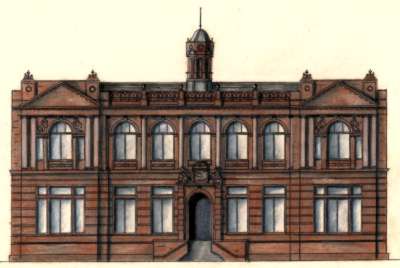
Edwardian Renaissance Libraries
The most noted Renaissance style library in Scotland is the Ewart Library in Dumfries, which was officially opened in 1904 by the donor of the site, Miss McKie. Mr and Mrs Carnegie also attended the ceremony, where Andrew Carnegie was presented with the freedom of the burgh.

Ewart Library, Dumfries.
The library building is an elaborately decorated two-storey red sandstone structure, with relief carvings of figures personifying Knowledge, Music, Art and Truth situated over the end windows. It is built in the Renaissance style with a seven bay frontage finished with polished granite Ionic columns and pilasters. The architect, Alan. B. Crombie used a style which was very popular in Scotland at the time, and variations on the same theme can be seen throughout the country.
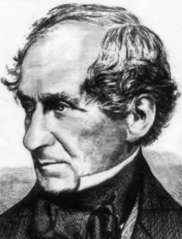
When Carnegie offered £10,000 for the Dumfries library building in 1898, he had suggested that the library be named after William Ewart (left), the former Member of Parliament for Dumfries. Ewart was responsible for the introduction of the Free Libraries Acts of 1850 in England, and 1853 in Scotland, allowing public libraries to be supported by local taxation for the first time. This led directly to the creation of public libraries in some enlightened places even before Carnegie began his donations.
The two great cities of North West England, Manchester and Liverpool, were the first to benefit from the legislation, with the Campfield Library Manchester opening on 2nd September 1852, followed by the Liverpool library on 18th October in the same year.
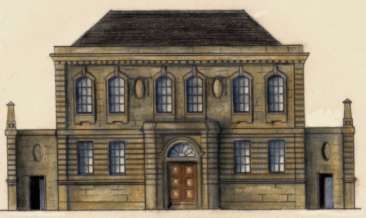
Burntisland Library, Fife.
Burntisland Library has a much more English feel than other Carnegie libraries built in Scotland. It would not look out of place amongst the fastidious conservative architecture seen in the university towns of southern England.
26 architects entered the competition to design the library which was won by William Williamson of Kirkcaldy with his Anglified Renaissance design. The library was then built on a site donated by James Shepherd of Kirkcaldy.
Burntisland is situated on the north bank of the Firth of Forth, close to Andrew Carnegie's birthplace in Dunfermline. Carnegie formally opened the library on 18th September 1907, while he was visiting Scotland to address the annual meeting of the Library Association. He was presented with the freedom of the burgh at the ceremony.
The following day, when the library was first opened to the public, the police had to control the crowds who wished to use their new library.

Carnegie Library, Ayr.
One of the earliest libraries of this style was the Carnegie Library in Ayr, which superseded an earlier subscription library dating from 1870. The trustees of the subscription library had invited Andrew Carnegie to give a lecture to the members in 1890. Carnegie declined this invitation, but instead offered £10,000 towards a free library for the town.
The two-storey library is built in local red sandstone to a lavishly embellished Italian Renaissance design by Campbell Douglas of Glasgow.
The seven bay façade features a central entrance leading to a large stairwell which contains a nine pane stained glass window displaying a portrait of Andrew Carnegie. The window also contains monograms of Andrew and Louise - AC & LW, as well as Carnegie’s ever present motto "Let there be light".
The library was officially opened on 2nd September 1893
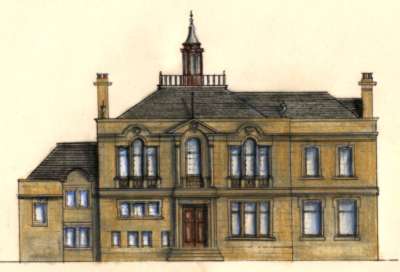
Motherwell Library, Lanarkshire
Motherwell's Carnegie library is situated in the centre of town, opposite the town hall. Carnegie had provided £12,000 for the library's construction.
It is a larger building than is usual for a town of Motherwell's size, but it would also have served the expanding Lanarkshire settlements which were surrounding the town at the beginning of the century.
The architects, Greig Fairbairn and Niven, built the library with cream sandstone to a conventional Renaissance design.
The library was officially opened on 5th April 1906 by Dr Hew Morrison on behalf of Andrew Carnegie. Provost Purdie thanked Dr Morrison and Andrew Carnegie on behalf of the people of Motherwell.

Carnegie Library, Coatbridge, Lanarkshire.
The Carnegie Library in Academy Street, Coatbridge is housed in a conventional red sandstone building which Andrew Carnegie provided £15,000 to construct. The façade is enlivened with carved shields on the side wings and a relief displaying the town's coat of arms over the main entrance.
The buildings's architect, Alexander Cullen, was very popular in the area and his works can still be seen throughout Lanarkshire. He did however venture further afield to design the library and Art Gallery in the English seaside town of Blackpool.
The library was officially opened on 7th May 1906 by Andrew Carnegie in person. He received the ceremonial freedom of burgh of Coatbridge from Provost McCosh during the celebrations. The Carnegie entourage then went on to visit the nearby town of Airdrie.
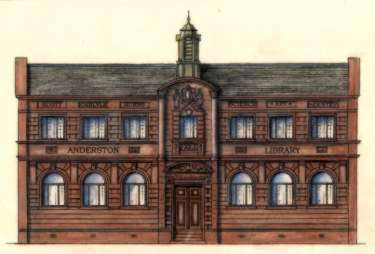
Anderston Library, Glasgow.
This was Glasgow's first free standing library. It has a two-storey façade built to a symmetrical Edwardian Renaissance design which shows elements of art nouveau. The architects, John Stewart & George Paterson, gave it a prominent highly decorated central bay with three sets of contemporary styled windows either side.
Anderston Library was the first of the city's Carnegie libraries to be demolished when it disappeared in 1969 as part of the redevelopment of the area.
The modern replacement, which opened in 1984, is situated within the Mitchell Library extension which was completed at the beginning of 1980, built on the site of the former St. Andrews Halls.
The library was officially opened on 21st December, 1904 by Councillor William Bilsland, who was later to become Lord Provost of Glasgow.
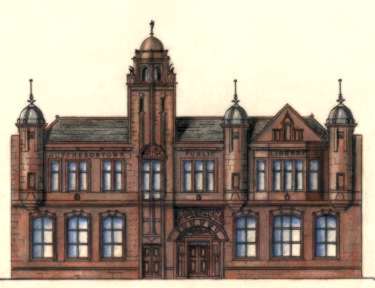
Hutchesontown Library, Gorbals, Glasgow.
This was the final and the most decorative of James. R. Rhind's Glasgow libraries, built in the French Renaissance style, completely different from any of his earlier Baroque buildings. It has an attractive square tower, crowned with an ornately decorated sandstone dome and surrounded with 3 smaller domed turrets. The 2-storey frontage and the tower are covered in elaborate carvings and figures in keeping with the overall theme of the building.
Local businessman John Woyka donated a collection of 112 natural history books to the new library in February 1907.
It closed on 31st July, 1964 and was partially occupied as a day nursery before being occupied as offices by Gorbals Initiative in 1994.
The library was officially opened on 17th November, 1906 by Baillie John Battersby.
Its current use is as offices.

Pollokshields Library in Glasgow, like the earlier Kingston Library, was designed "in-house" rather than by a private architect. The plans were prepared by Thomas Gilmour of the Office of Public Works, supervised by the City Engineer & Surveyor, Alexander. B. McDonald (left). The final result is pleasing to the eye even if it does lack the panache of J.R.Rhind's libraries.
The library was officially opened on 20th February, 1907 by Sir John Stirling Maxwell, who was an extensive local landowner and donor of the site.
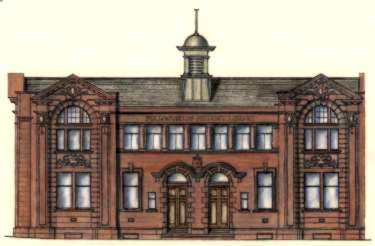
Pollokshields Library, Glasgow
The regular two-storey red sandstone façade was built to a much more formal style than the free flowing forms used in some of Glasgow's earlier libraries.
The front has been brightened up by the use of carvings and motifs. Internally the library is very spacious and is well lit from the two streets which it faces.
Its current use remains as a branch library.
Possilpark Library, Glasgow.
This library was the first to be built with the additional funds supplied by Carnegie in 1908 to complete the programme of branch libraries in the city. It was designed by George Simpson of Glasgow.
The library was officially opened on 15th March, 1913 by the Lord Provost, Daniel Macauley Stevenson.
Its current use remains as a branch library.
Langside Library, Glasgow.
This was the final Carnegie library of Glasgow, being completed after the outbreak of the Great War, which marked the end of an era in architectural as well as in many other respects.
The library was officially opened on 3rd February, 1915 by the Lord Provost, Thomas Dunlop.

The neat single storey building occupys a corner site, displaying two distinct frontages.
The Italianate design has an attractive ornamented entrance on the main frontage to Allander Street.
Internally the library was decorated by four panels by students of the Glasgow School of Art at a cost of £50. These are still in very good condition and worth a visit.
Its current use remains as a branch library.
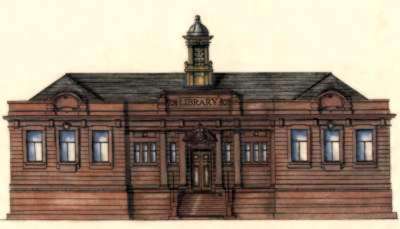
Like Possilpark, it was designed by George Simpson.
The single storey building has a plain though agreeable symmetrical frontage in three bays. The city's coat of arms is featured above the central entrance; otherwise the façade is relatively unadorned in comparison with the earlier Glasgow libraries.
Its current use remains as a branch library.
Carnegie Libraries of Scotland: Architecture & History

 Introduction
Introduction
The Carnegie Libraries
 Andrew Carnegie
Andrew Carnegie
His Scottish connections
 Early Carnegie Libraries
Early Carnegie Libraries
The first in the world
 American Libraries
American Libraries
A comparative study
 Scottish Architecture
Scottish Architecture
Unique libraries
 Renaissance
Renaissance
Edwardian architecture
 Baroque
Baroque
J.R. Rhind in Glasgow
 Library Architecture
Library Architecture
Diverse designs
 Inside the Libraries
Inside the Libraries
Photographs from 1907
 Carnegie Hero
Carnegie Hero
John Blaikie in 1911
 Exhibition
Exhibition
Landmarks of Literacy